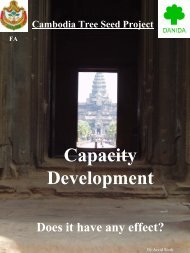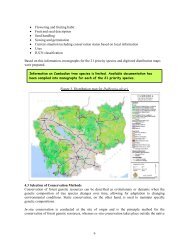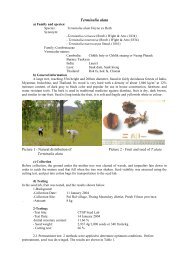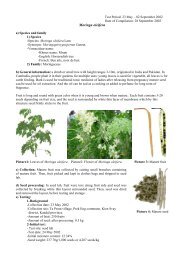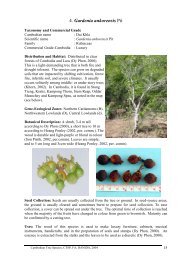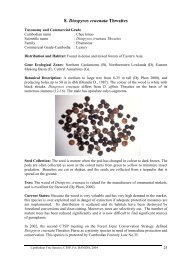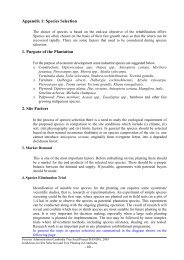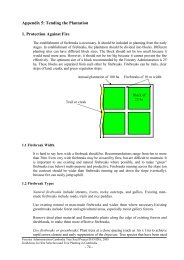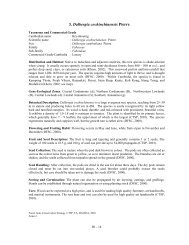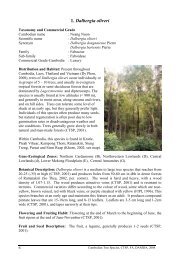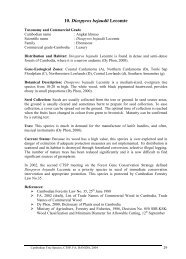Introduction - Cambodia Tree Seed Project
Introduction - Cambodia Tree Seed Project
Introduction - Cambodia Tree Seed Project
Create successful ePaper yourself
Turn your PDF publications into a flip-book with our unique Google optimized e-Paper software.
list for <strong>Cambodia</strong> is expected to exceed 3,000 species (Dy Phon, 2002, pers. comm.), with<br />
expectations that at least 700 additional species will be described as new to science in the<br />
country. It may be assumed that a minimum of ten percent of these species will be endemic<br />
to the country. The World Conservation Monitoring Centre 2000 estimates 8260 plant<br />
species in <strong>Cambodia</strong>, 10% endemic of which will be endemic. There is, therefore, still<br />
considerable scope for further documentation of the flora of Indochina. This is thought to be<br />
particularly true for <strong>Cambodia</strong>, which has never undertaken a systematic, national inventory<br />
of its flora.<br />
Dy Phon (1970, 1971) provides the only systematic vegetation survey that considers<br />
all vascular flora of an area. Her treatise of the flora and vegetation of the Bay of Kampong<br />
Som, Phnom Bokor of the Elephant Mountains, and the Kirirum plateau, as well as Ashton's<br />
(1964) brief descriptions of the coastal hinterlands of the Cardamom Mountains, represent the<br />
more substantial botanical works in <strong>Cambodia</strong>.<br />
Dy Phon's work has been complemented by a range of forest inventories and surveys<br />
of medicinal and other useful plants (eg. Ashton 1964; Eav Bov Bang 1970; FAO 1970;<br />
Martin 1973, 1997; and Rollet 1962, 1972a, 1972b and 1972c). Forest inventories were not<br />
accompanied by assessments of the full range of plant resources, and no naturalist has ever<br />
described forest areas over 1,100 meters elevation in <strong>Cambodia</strong>. Rollet (1972c) provides,<br />
however, a preliminary listing of some common genera at higher altitudes. Legris and Blasco<br />
(1971, 1972) and Dy Phon (1981) have synthesise much of this information to provide a<br />
national overview of <strong>Cambodia</strong>'s vegetation types and their principle species. More recently,<br />
McDonald et al. (1997) conducted a detailed survey of the flora of the Tonle Sap floodplain,<br />
and in 1998, FAO undertook the establishment of a forest inventory process with MAFF/FA.<br />
From 1998 to the present, the FA, in cooperation with international environmental NGOs<br />
such as FFI, ARA, CAT, WCS, WWF, and CI, have conducted conservation surveys. The<br />
result of these activities has led to some updates to the <strong>Cambodia</strong>n check list of especially<br />
fauna, and to lesser extent of flora. They have also established three new protected zones in<br />
the Cardamom Mountain region.<br />
<strong>Cambodia</strong>n forests are dominated by species of Dipterocarpaceae, Leguminosae,<br />
Lythraceae, or Fagaceae, and in some places Pinaceae, Podocarpaceae, or bamboo. Lowland<br />
floras of <strong>Cambodia</strong> are typical of the Indochinese Floristic Province (and as such, contrasts<br />
with that of Chinese, Indo-Burmese, and Indo-Malayan Biogeographical Provinces), whilst<br />
the highland floras share a closer affinity with those of the Indo-Malayan region (Dy Phon<br />
1982).<br />
Legris and Blasco's (1972) vegetation map remains the most ecologically sensible<br />
map for <strong>Cambodia</strong>n forests, even though considerable deforestation and degradation has<br />
occurred since the time of their study. This earlier map has recently been reviewed, and is<br />
commercially available through the French company ECOCART, though not yet available in<br />
<strong>Cambodia</strong>.<br />
Whilst in recent times botanical research has increased, many species are yet to be<br />
documented. In view of the rapid depletion of the forest resources, such work is of great<br />
importance in order to identify useful species before they are lost. Such information will lead<br />
to the identification of appropriate options for different forest management systems.<br />
High market prices and demands for commercial trees are leading to the extinction of<br />
rare and endangered species in <strong>Cambodia</strong>. As forest resources continue to be depleted,<br />
2<br />
<strong>Cambodia</strong>n <strong>Tree</strong> Species, CTSP, FA, DANIDA, 2004



